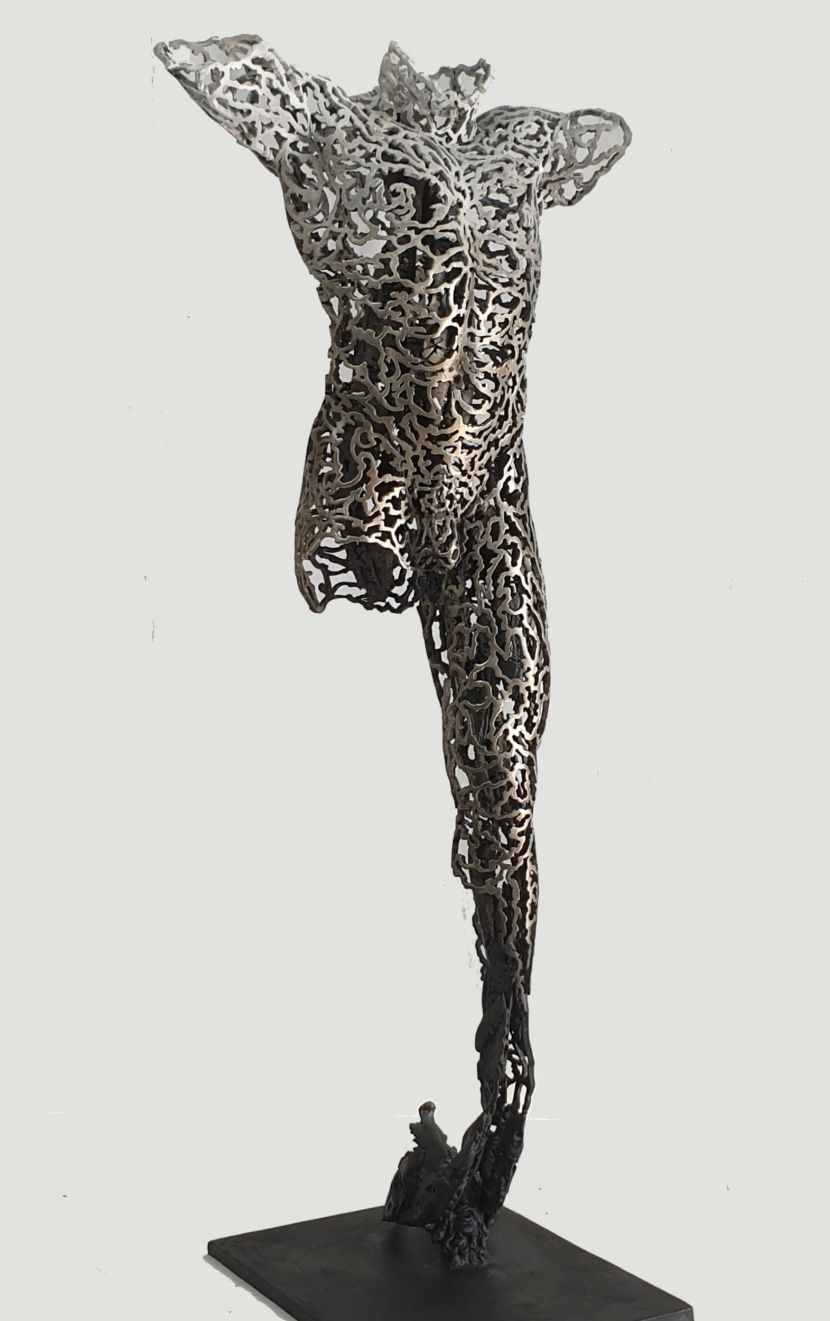Andromeda Collection: formal anti-matrix transmutations by BLAKE WARD
By Jacqueline Ceresoli
From Andromeda, a bronze sculpture made using traditional methods, after being digitally scanned and loaded into the CAD software "ZBrush", comes Devorah, a digital sculpture created from the original scan, apparently similar but not the same as the first. From the traditional bronze creation, BLAKE WARD moves on to experiment with another way of making sculpture, no longer in bronze, but through an elaborate digital program with the aim of giving dynamic form to fluid bodies stretched towards dematerialisation with the SLS 3D power bed printer in a wax polymer and cast in bronze: it is an alternative to the lost wax creation process in a digital version.
There is only one bronze prototype of Devorah, while Enseladus and Callisto are clones of digital sculptures that are inscribed in gesture and two-dimensional computer manipulation. These disturbing acephalic bodies, alchemical fragments, mould fluid and solid forms in the image and not in the material.
WARD, faithful to his investigation of the body, poised between myth and classical citations, has for years been recognised for his obsession: the human figure as a premise for the investigation of metamorphic and dynamic processes as a critique of the static nature of classical sculpture. The novelty of his research lies in the technique and process of digital sculpture, in which the work is the invention of a sculpture out of matter as an event of the plastic arts.
In the sculptures of the Anromeda Collection, the artist moves from the full to the empty, from the attraction of matter inscribed in space to its excavation in the void of the net, freed from the pedestal, visualising the process of dematerialisation with the digital "chisel" of liquid forms knotted by white filaments. His aesthetic provocations weave shapes around the void in which their materiality is completely irrelevant. They are sculptures that do not present themselves as icons, manifestos of antimatter resolved in fluid and metamorphic silhouettes that take shape in the image as material for rethinking sculpture in a conceptual key with new digital languages to be touched with the eye and interpreted as a powerful aesthetic challenge, in which the sublime includes a form of ideal Beauty.
Nietzsche wrote that aesthetics (i.e. art) is specifically interminable. Ward, faithful to this principle of indeterminacy, even of human existence, finds in digital sculpture the essence of art and the derivation of the future.
The artist, like God creates the non-existent, gives form to a work of art as the result of an irreversible process of materialising the idea of sculpture and not the physical object itself as a finished product. BLAKE's imaginative digital sculptures oscillate between tradition and innovation, they look like Avatars of a transgenic materiality that appeal to mythology, implying in the process of elaboration of the work, the search for overcoming three-dimensionality with new languages yet to be explored.
His digital sculptures as a practice of reflection and expressive freedom of art released from the limits of matter and from any support of the objective work, in which different practices, techniques and languages are constantly renegotiated, aimed at rethinking the interaction between matter and its opposite, poised between finite and infinite object with visual objects that are self-determining in the image.
Blake Ward in the digital culture, finds in the sophisticated high definition technological programs a tool to give visibility to his desire to shatter the matter, with objects and subjects at the same time of other than itself, in which the "sculpting" inside the void is more interesting than in front of the work, to free an idea of total visibility that finds a possible expressive potential.
The Canadian artist, who has always been attracted to a dynamic, kinetic approach to sculpture, acts on the non-material of digital sculpture to investigate the trace, the imprint of an experience in metamorphic form and in perpetual becoming, scanned with innovative processes.
The means but not the end of his refined digital processing is to construct immaterial plastic voyeurisms, paradoxically fetishistic around the dissolution of the body: the myth of classical art.
Critic from Yvonne Gregory
Conceptually you have taken a brave step forward in choosing to reveal more of the internal, through the exposure of the armature. This structure reminds me of the metal posts that make a scaffolding structure, usually seen on the outside of a building. Your poles are inside the building and the body is formed around them. I wonder if this scaffolded structure could be you starting to reveal yourself in your work?...The bronze finish has a painterly feel about it, resembling an outer shell that might be dissolving.
That you chose to expose the inner structure/support system, is what I find most interesting. What else might there be to reveal? How might it look without the obvious body section that surrounds it? Will the on lookers relationship to this be more visceral?
If you were able to expose more, of what is actually there, without the desire to cover anything, this might be a pure and uncontrolled exercise in 'less is more.' Some of the best Art is about drawing the viewer to fill in the absent. What do you think?
The actual body shell is (I think) conventional in it's beauty, who's physique, somehow, did not convey the vulnerability you might have intended. Intentional or not, I’m excited for you about your new developments, talking of development Im taking new photo's, who knows where that might go...
Space In Between
The Beauty and Complexity of Blake Ward’s Sculptures
By Amy on 15 May 2016 in Chicago
Blake Ward’s beautifully crafted sculptures are analogous to the inner qualities of our human existence.
Blake Ward, “Phantom Sky.” Image provided by Hilton-Asmus Contemporary, credit Blake Ward.
Blake Ward's newest sculptural series, Spiritual Collection, is typified by “Ushabti Renenet.” This bronze statue of a woman’s body stands less than three feet tall, and is missing several body parts: a head, both arms and a leg. Shoulders are square and back is arched; the body weight is supported by one strong leg, perched high on the left toes. The intact limbs are fragmented, but “Ushabti Renenet” exudes confidence: she is bound for another place, and not committed to the small pedestal on which she stands.
This piece is at the essence of “Inner Perceptions, Outer Reflections” at Hilton-Asmus Contemporary in Chicago, and demonstrates Ward’s interest in the human spirit. The figure evokes traditional associations of the female nude: ideal body proportions and graceful forms. But sensuality is quickly usurped. Move around the sculpture and the figure’s inside layers are revealed—analogous to the inner qualities of our human existence. The visitor is presented with a decision: see the sculpture for its exposed physical beauty; its metaphysical qualities; or both.
“Inner Perceptions, Outer Reflections” addresses this dichotomy. Ward, a Canadian-born artist, has long created figurative works. His Spirit Collection comprising this show deviates from his past work of solid three-dimensional sculptures. The exposed bodily interiors are a point of distinction: enabling the visitor to see in and through the figures. The representation underscores Ward’s appeal in the inner quality of his work and our human existence—including determination, integrity and spirit—as the artist explains on his website. This series suggests there is more to a person than what is perceived from the outside, and poses the visitor with a challenge: to focus on the person within, not just outside the body.

